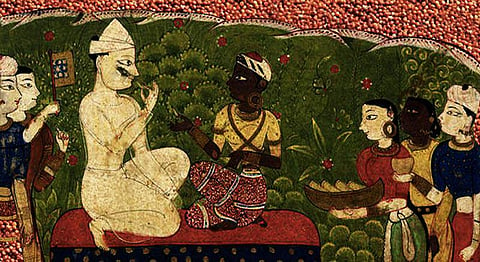
- HOMEGROWN WORLD
- #HGCREATORS
- #HGEXPLORE
- #HGVOICES
- #HGSHOP
- CAREERS
- ABOUT US
- CONTACT US

Unlike the other kings of the 12th century Western Kalyani Chalukya empire, King Someshvara III was more of a poet than a warrior. Son of King Vikramaditya VI, Someshvara III was lucky enough to inherit a kingdom that was essentially at its strongest. Thus freed from the colonial pursuits of his predecessors, Somesvara III was free to live a real kingly experience, enjoying a more literary life, and so he did. Though there is little known about King Someshvara III’s personal life, his detailed 12th century Sanskrit manuscript, Manasollasa, provides an insight into his luxurious lifestyle (and has a great idli recipe!).
The Manasollasa, which means ‘happiness of the mind’, is essentially a pocket guide on how to be an Medieval Indian king – the book covers everything from the importance of having four palaces (one for every season, of course) to how to prepare and serve food to the king. Written almost entirely in poetic verse, the book is divided into five sections: Rajyapraptikarana (qualifications of the king), Rajyasya Sthairyakarana (governance and politics), Bhartur Upabhogakarana (food), Pramoda Karana (entertainment) and the Krida Vimsati (games and recreation).
Though not specifically a cookbook, the Manasollasa is one of the oldest Indian texts to describe cooking ingredients and instructions. According to culinary historian Mary Ellen Snodgrass, the Manasollasa and its extensive section on recipes predate the writing of cookbooks in Medieval Europe by nearly a century, making it possibly one of the oldest cookbooks in the world. The Manasollasa’s ‘Bhartur Upabhogakarana’ details recipes for cooking rice, daal, and assorted vegetarian and non-vegetarian dishes.
A number of the dishes described in the Manasollasa are easily identifiable as ancestors of staples of modern Indian cuisine. For example, the book describes ‘iddarikas’, which seem to be a medieval version of the idli. Essentially the same as the modern idli, Somesvara III’s iddarikas differ in that they are made of a fermented batter of ground urad dal, in place of the rice and dal batter used in idlis today. Another recipe, the gharika, a sweet fried cake made from the same batter as the iddarika, seems to be a distant relative of the modern jalebi. Another notable difference is the way in which the Manasollasa describes the cooking of rice – rather than simply steaming it, Somesvara III says that rice must be mixed and served with milk and ghee to be fit for a king.
A couple of the recipes also seem quite outlandish. One recipe describes the appropriate way to fry a black rat.
Not only does the Manasollasa describe recipes, but it also explains the appropriate way to serve them to the king and his family. For one, the king should only ever be served food in plates and bowls made of, or coated in, gold. The book also mentions that the king may sit facing East to secure a long life - facing West will ensure wealth, facing South will lead to a comfortable life, and facing North ensures mean good health.
So, if you’ve ever wondered what it would be like to dine like a 12th-century king, look no further. The Manasollasa has all the instructions you need.
You can find some of the recipes from the Manasollasa here.
Featured image purely for representational purposes, via Hindavi, The Kitchens of History.
If you enjoyed this article, we suggest you read:
